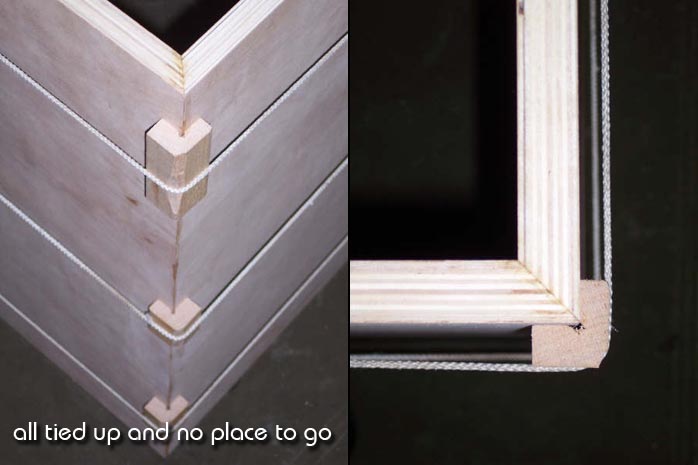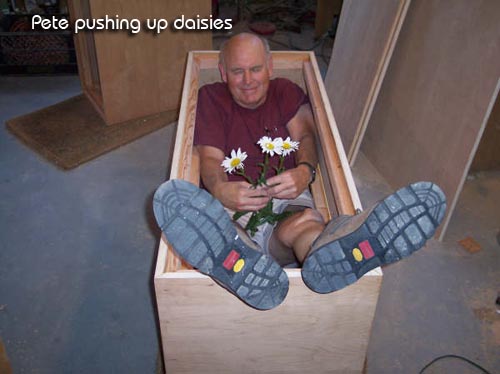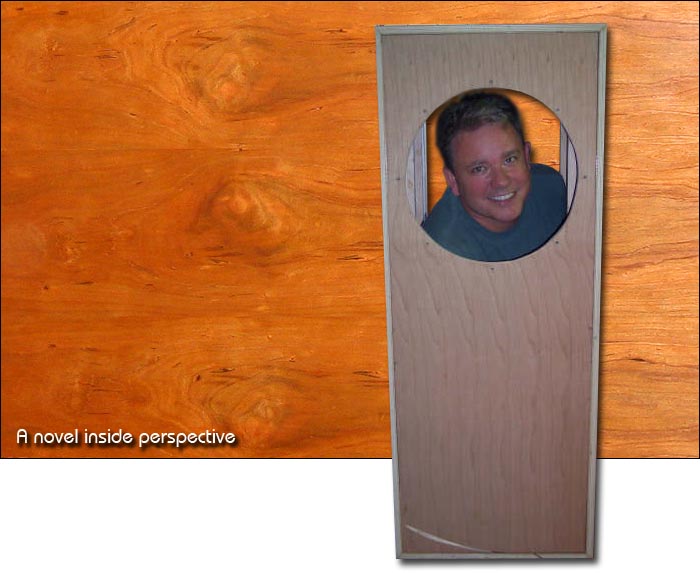|
|
|
|
|
|
|
This review page is supported in part by the sponsor whose ad is displayed above
|
|
 |
|
I'm already visualizing the duct tape over my mouth.
I must have entered a chemically inconvenienced state at some point because somewhere along the line, I artlessly asked Pete what the drivers would require by way of a sealed box. My bad. Too little, too late, I quit reading his emails after this exchange.
Pete wrote: Stephæn and Jay, okay. An optimally flat, sealed box using a tube amp has a 3dB down point of 75.1Hz and a roll-off at 12dB/octave below that. The box, if unstuffed, has a volume of 3.31ft² plus we add a .24ft² for the volume taken up by the driver for a total of 3.55 cubic feet. Partially stuffed, the box has a volume of 2.76ft² plus we add .24ft² for the volume taken up by the driver for a total of 3.55 cubic feet. These are internal volumes. For a sealed speaker, if we start adding electrical resistance to the electrical circuit, the cutoff frequency will drop, the box will become larger and the efficiency of the speaker will drop. I'll eventually make some calculations with added resistance but I find it hard to accept giving up speaker efficiency and maybe audible dynamics by adding resistance.
Jay replied: Well guys, you know where this is leading, don't you? It leads to something I discussed briefly with you on the phone ... to the next insane speaker that I will build which is the 604s in optimally flat sealed boxes, with JBL 2245H 18" woofers in their own vented cabs underneath each sealed 604 cab. The 2245Hs would be driven with plate amps with their own built-in xover. Overall size would be about the same as what I have now. Now we're talkin', baby!
Pete's rejoinder: Jay, you are having way too much fun. Systems like that aren't even street legal in Eastern Washington State. How are we going to keep Stephæn on the farm if you keep talking like that?
Gevalt!
Next thing I know it's May but the sunny news is that all the components and materials have arrived and we're geared up to cut wood. By this time Pete has done a bundle of Martin King-type simulations on diverse boxes. They're all precisely set into a binder that grew by the week with plans and notes and oh-so-much more. You want Pete on your team for sure. He is now happy at 10 cubic feet of internal volume, having found out pretty much what Jay and associates had found. Specifically, Pete established that with the large box without extra added electrical resistance on the woofer circuit, there is a gradual 2dB drop in response between 400Hz and 40Hz -- not much considering that it is spread over three octaves -- followed by the real roll-off beginning at 40Hz, with 35Hz being 3dB below 40Hz. Also, the reckoning implied a natural box frequency down in the mid thirties for the large box and in the mid forties for smaller boxes. In Jay's design calculations, 3 ohms of resistance were added to the woofer circuit, which eliminates the droop but also lowers bass efficiency by about 3dB.
One supplementary finding was that with resistance added to the woofer circuit and an increase in the Q total of the woofer, there is a Thiel-Small Bessel alignment that has a box resonance frequency of 30Hz and a cutoff frequency of 46Hz.
Déja Moo: The feeling that you've heard this bull before.
Pete's calculations may have seemed to drag on forever but to be completely evenhanded, he encouraged me early on to stick to my initial desire to try building what I'd heard in Denver. He was never ever lost and his mock-ups of alternative destinations were sufficiently comprehensive to make me wonder on occasion. I had pretty much thought all along that we would end up building the bigger, more Rubenesque type of box I heard at RMAF. There really was no way Pete was gonna talk me into some scrawny, coke-snortin' fashion model of a cabinet. In this case (as it were), bigger will be better.
On May 6th, I had to conjecture no more.
Pete wrote: æ, I found a source in Spokane for veneered plywood in the kind of quality we want. Local sources seem to be pretty sad but I'm always ready to be surprised by a new find. If you hear of anything let me know. The company in Spokane is Windsor Plywood and Hardwood, a Canadian company with many stores all over Canada but only two U.S. outlets, one in Spokane and one in Bellingham. They have a good stock of many high-quality plywood species and a great stock of hardwood for the trim pieces we need on each side of the front panels.
We want to use high-grade veneered plywood because DIY veneering is more expensive than high grade veneered plywood, lacks certain advantages, has lower build quality, more labor and greater risk even for the professionals. And the risks are not just immediate. DIY veneer failure could occur several years out. But not with factory veneered plywood. I ran my hand over and gazed at several species of top-grade 3/4" plywood today. The most exotic of the bunch happened to be zebra wood (for years it was called Zebrano) in wavy tan and chocolate stripes. Pretty damned gorgeous.
Some very gorgeous nice teak, ribbon-cut mahogany, flat-cut mahogany, cherry, walnut, hickory, maple, birch and oak as well. I think this company will find some Brazilian Rosewood plywood and give us prices on that if that's what we want so we could order it if that is your choice. We will be able to get book-matched panels so the fronts of the two cabinets will have identical and symmetrical grain.
As it turned out, we chose cherry for the appearance surface and aren't even a little bit sorry. The cost of the three sheets of plywood in cherry was about $270. In rosewood it would have been about $700. We had no idea how beautiful the cherry would become when we finally applied a Watco oil finish in the Watco product labeled Natural.
|
|
Optimist: "Opti" meaning "eye" and "mist" meaning fogged up. You understand. Su-weet! Construction began on May 27th. We got one carcass (just the four sides) cut and glued. That was a lot of work! I learned that big boxes are a real challenge to cut and assemble. I learned that even good quality plywood is not always perfectly flat. I learned that large panels could be very difficult to handle. By May 29th we had the second carcass cut and glued as well. "Progress," I thought. "We'll be done in a couple of weeks." I hadn't an inkling what I was in for.
May 31st.I've got mail! Dare I read it though?
|
|
|
|
 |
|
Pete wrote: æ, went to Home Depot and picked up some nice 2" x 6" fir lumber for the front and rear cleats and for the corner gussets that will back up the miter joints. Cut up enough 1" x 1.5" strips to do the cleats that go inside the rear and inner front panels. Got the four long cleats cut for one box. One of the cleats is glued in. They will go in one at a time. Just enough simple spring clamps of the right size here to do it that way. I can glue in one cleat every couple of hours tomorrow, letting the glue set about an hour before removing clamps. Looking good.
What? Cleats, corner gussets and clamps? Oh my - somehow none of this was mentioned before.
|
|
|
|
 |
|
The fuck-up fairy pays a visit.
June 5, 2006, Pete wrote: æ, the signature panel came out just fine when weight was removed. Looks like it glued well to the cleats. Gluing continues on cleats for left channel box. Only three more cleats to go. I'm starting to play with finishes on test strips. Any time you want to drop by we can work on front and rear panels. No rush.
Ah, yes - see the lower left corner of the speaker on the left? That's what we kindly dubbed a signature. After all, what would a DIY project be without one? Fortunately, it did not involve any bloodstains. This came courtesy of the combination of a 4" x 8" foot panel, a rather large table saw and, yup, you guessed it - Physics.
June 24th. Pete returned from a vacation of sorts and we're back at it again. Let's see, that's the day we began cutting the vents in the underside of each cabinet. We decided on two vents with a collective area a little larger than the real estate of one 6" diameter hole. Within walking distance of Jay's design but with a literal twist. We opted to use our mad scientist invention 'dial-a-vent' that I later chose to trademark as the Dial-a-Hole. "We just in-vent-ed it," says Pete. Ouch!
The two vents were now covered by a rotational figure-8 disc with openings the same size as the vents. If we wished to experiment with smaller vents -- or even seal the cabinet -- we could simply rotate the disk to do so. We decided to use trial stands under some 4" x 4" feet cut from remnants until we knew how high off the floor we wanted to be. We were thinking around six inches but wanted to have the elasticity to avoid boom depending on room placement and settings on the Dial-A-Hole®.
We also set up to cut the holes for the drivers in the 1.5" thick baffles -- only the baffles are 1.5" thick -- but we hung it up late in the day when we were getting a little worn out and the craftsmanship was in peril. Those openings needed to be just right. Besides, the temperature had been hotter than hell in the shop and it was time for us to refill our liquid grain storage facilities.
|
|
|
|
Halle-freakin'-luiah ' maybe
We pretty much completed the boxes around 10PM on Thursday, July 6, 2006. Still required was trim for the edges and some other finish work but the Bad Boys Benevolent Association (BBBA) was due to convene over the weekend and that crew expected to hear some results. Accordingly, the details would have to wait a bit. Pete had previously designed -- and then let me help him assemble -- a highly functional crossover board that allowed for quick experimentation with various resistor values via alligator clips.
|
|
 |
|
| After hauling the beasts -- they were anything but Dream Speakers when on the dolly -- |
|
|
from the workshop up the rolling hill to Pete's house, we gave a listen for two hours and heard them begin to unfurl. But, all was not well as only changes in the middle and high frequencies revealed themselves. Pretty amazing the kind of changes we heard but still no real bass to speak of. Something was clearly wide off the mark. And that was still the case on Friday and Saturday, though we continued to hear other changes for the better during the four or five total hours we listened. You couldn't blame the Bad Boys for not being impressed or for insistently asking, "where's da basz?"
|
|
 |
|
|
 |
|
|
|
 |
 |
|
|
 |
|
|
|
|
|
|
|
|
|
|
|
|
|